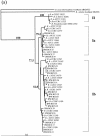PCR assay of the groEL gene for detection and differentiation of Bacillus cereus group cells
- PMID: 12902235
- PMCID: PMC169126
- DOI: 10.1128/AEM.69.8.4502-4510.2003
PCR assay of the groEL gene for detection and differentiation of Bacillus cereus group cells
Abstract
Strains of species in the Bacillus cereus group are potentially enterotoxic. Thus, the detection of all B. cereus group strains is important. As 16S ribosomal DNA sequence analysis cannot adequately differentiate species of the B. cereus group, we explored the potential of the groEL gene as a phylogenetic marker. A phylogenetic analysis of the groEL sequences of 78 B. cereus group strains revealed that the B. cereus group strains were split into two major clusters, one including six B. mycoides and one B. pseudomycoides (cluster II) and the other including two B. mycoides and the rest of the B. cereus group strains (cluster I). Cluster I was further differentiated into two subclusters, Ia and Ib. The sodA gene sequences of representative strains from different clusters were also compared. The phylogenetic tree constructed from the sodA sequences showed substantial similarity to the tree constructed from the groEL sequences. Based on the groEL sequences, a PCR assay for detection and identification of B. cereus group strains was developed. Subsequent restriction fragment length polymorphism (RFLP) analysis verified the PCR amplicons and the differentiation of the B. cereus group strains. RFLP with MboI was identical for all the B. cereus group strains analyzed, while RFLP with MfeI or PstI classified all B. cereus and B. thuringiensis strains into two groups. All cluster II B. mycoides and B. pseudomycoides strains could be discriminated from other B. cereus group bacteria by restriction analysis with TspRI.
Figures


Similar articles
-
Molecular discrimination of Bacillus cereus group species in foods (lettuce, spinach, and kimbap) using quantitative real-time PCR targeting groEL and gyrB.Microb Pathog. 2018 Feb;115:312-320. doi: 10.1016/j.micpath.2017.12.079. Epub 2018 Jan 3. Microb Pathog. 2018. PMID: 29306007
-
The possibility of discriminating within the Bacillus cereus group using gyrB sequencing and PCR-RFLP.Int J Food Microbiol. 2005 Sep 25;104(1):113-20. doi: 10.1016/j.ijfoodmicro.2005.03.015. Int J Food Microbiol. 2005. PMID: 16005534
-
Differentiation of strains from the Bacillus cereus group by RFLP-PFGE genomic fingerprinting.Electrophoresis. 2013 Nov;34(20-21):3023-8. doi: 10.1002/elps.201300246. Epub 2013 Sep 25. Electrophoresis. 2013. PMID: 23893780
-
[Evaluation of multiplex PCR to identify the species of microorganisms from Bacillus cereus group].Med Dosw Mikrobiol. 2012;64(2):101-8. Med Dosw Mikrobiol. 2012. PMID: 23072054 Polish.
-
Fluorescent Amplified Fragment Length Polymorphism Analysis of Norwegian Bacillus cereus and Bacillus thuringiensis Soil Isolates.Appl Environ Microbiol. 2001 Oct;67(10):4863-73. doi: 10.1128/AEM.67.10.4863-4873.2001. Appl Environ Microbiol. 2001. PMID: 11571195 Free PMC article.
Cited by
-
Phenotypic diagnosis and genotypic identification of Bacillus cereus causing subclinical mastitis in cows.Vet World. 2023 May;16(5):888-894. doi: 10.14202/vetworld.2023.888-894. Epub 2023 May 7. Vet World. 2023. PMID: 37576758 Free PMC article.
-
Differentiation of Bacillus anthracis, B. cereus, and B. thuringiensis on the basis of the csaB gene reflects host source.Appl Environ Microbiol. 2013 Jun;79(12):3860-3. doi: 10.1128/AEM.00591-13. Epub 2013 Apr 5. Appl Environ Microbiol. 2013. PMID: 23563945 Free PMC article.
-
Development of peptide nucleic acid-based bead array technology for Bacillus cereus detection.Sci Rep. 2023 Aug 1;13(1):12482. doi: 10.1038/s41598-023-38877-1. Sci Rep. 2023. PMID: 37528159 Free PMC article.
-
Assessment of genetic diversity of Bacillus spp. isolated from eutrophic fish culture pond.3 Biotech. 2015 Aug;5(4):393-400. doi: 10.1007/s13205-014-0234-9. Epub 2014 Jul 2. 3 Biotech. 2015. PMID: 28324539 Free PMC article.
-
Meat and meat products as potential sources of emerging MDR Bacillus cereus: groEL gene sequencing, toxigenic and antimicrobial resistance.BMC Microbiol. 2024 Feb 7;24(1):50. doi: 10.1186/s12866-024-03204-9. BMC Microbiol. 2024. PMID: 38326741 Free PMC article.
References
-
- Angus, T. A. 1954. A bacterial toxin paralyzing silkworm larvae. Nature 173:54-56. - PubMed
-
- Ash, C., J. A. Farrow, M. Dorsch, E. Stackebrandt, and M. D. Collins. 1991. Comparative analysis of Bacillus anthracis. Bacillus cereus, and related species on the basis of reverse transcriptase sequencing of 16S rRNA. Int. J. Syst. Bacteriol. 41:343-346. - PubMed
-
- Ash, C., and M. D. Collins. 1992. Comparative analysis of 23S ribosomal RNA gene sequences of Bacillus anthracis and emetic Bacillus cereus determined by PCR-direct sequencing. FEMS Microbiol. Lett. 94:75-80. - PubMed
-
- Beattie, S. H., and A. G. Williams. 1999. Detection of toxigenic strains of Bacillus cereus and other Bacillus spp. with an improved cytotoxicity assay. Lett. Appl. Microbiol. 28:221-225. - PubMed
MeSH terms
Substances
LinkOut - more resources
Full Text Sources
Other Literature Sources
Molecular Biology Databases
Research Materials

